Expanded Text Ads: Analyzing Early Performance Results

A couple months ago, Google announced its latest implementation to Search advertising with the introduction of Expanded Text Ads. The new installment, which Google touted as being the biggest update to creative since the introduction of AdWords itself, prompted a bit of buzz among the ecommerce community.
The announcement was significant for a number of reasons. For one, the format changed. It incorporates two headline fields instead of one, an 80-character description field, a modified URL, and better optimization for mobile platforms – altogether resulting in a nearly 50% increase in text space.

What created the most noise, however, is the fact that expanded text ads will soon be replacing standard text ads entirely.
As a whole, this represented a big change for Google, advertisers, and online shoppers. With the transition from the standard to expanded format being an inevitable conclusion, we wanted to take a look at how well expanded text ads have been performing so far.
To do this, we looked at internal data and compared performance between expanded text ads and standard text ads being run simultaneously.
In terms of metrics, we took into account Click-Through-Rates (CTRs), Average Cost-Per-Click (Avg CPC), and conversion rates, among other performance indicators.
Checking on the early performance of expanded text ads concluded with a fairly simple answer: so far, it’s a mixed bag.
It’s important to note that each of the following cases mentioned are in the digital retail industry using Branded text ads. ETAs, and ads in general, behave differently for each business (i.e. service vs. product) and should always be taken into account.
In our first example, performance of expanded text ads and standard text ads were compared over a 30-day period in which both formats were running simultaneously.
For the most part, ETAs presented improvements across the board compared to its standard counterpart.
We saw significant increases in CTRs, Conversion Rates, and a bump in ROI. Additionally, we noticed a decline in the Average Cost-Per-Clicks across all devices.
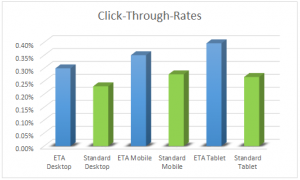
As you can see, expanded text ads produced noticeably better CTRs on each device. What’s particularly interesting in these numbers are where the changes took place.
Google heavily claimed its new ETAs as being optimized specifically for mobile devices, which is exactly where we saw the most pronounced CTR gains; mobile and tablet devices showing an increase of 7.37% and 12.99%, respectively.
We can speculate that the bump in CTRs helped improve the quality score of the ads, and as a result, decreased the average CPCs.
ETAs in this example performed incredibly well and stood as a strong baseline moving forward.
In the next example, we again looked to compare sets of standard text ads and expanded texts being run simultaneously over the same amount of time.
What was interesting about this example is that when comparing the different performance indicators, many of the metrics fell flat or displayed very incremental differences.
In reviewing CTRs, expanded text ads performed better, but not by a significant amount.
Between both desktop formats, ETAs held a 2.11% bump. On mobile devices, there was just under a 1% increase. The major differentiator came in on tablet devices, with ETAs producing a nearly 5% hike.
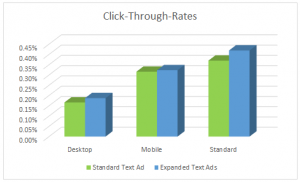
CPCs didn’t present a major change between both formats. Mobile and tablet CPCs had minimal cost differences. However, standard text ads on desktop were much higher than ETAs, costing over twice as much.
Changes in conversion rates between both formats were fairly minimal as well.
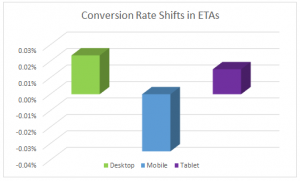
With a nearly 2% and 3% jump, desktop and tablet both had conversion rate increases compared to their standard equivalents. Mobile had the biggest shift, declining by over 3% in the expanded format.
In this instance, ETAs did not have a large impact compared to standard text ads. ROI was better for the most part, but CTRs, CPCs, and conversion rates remained unchanged outside of small bumps and dips here and there.
In our third and final example, the results were particularly interesting compared to preceding instances.
With this particular account, ETAs outperformed standard text ads by a significant amount in just about every metric. Click-through-rates, conversion rates, and ROI metrics all saw major improvements.
So much so, that instead of comparing ETAs to standard text ads, we chose to look at two different sets of expanded text ads that are being used for A/B testing and measured results between them.
Each set produced the following:
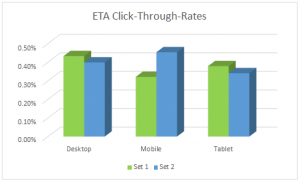
Right off the bat, the first set of expanded text ads appeared the be performing better when measuring CTRs. Set 1 had higher CTRs on both desktop and tablet, but came up short on mobile.
Desktop produced an increased CTR by 3.43%, while tablet was only slightly higher at 3.79%. Mobile, however, was more prevalent in set 2, which was higher by over 13%.
While the differences were not groundbreaking between the two, the higher CTRs on mobile were definitely worth noting.
In our next metric, set 2 ended up winning out as it produced better conversion rates.
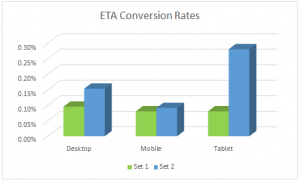
Set 2 outperformed set 1 on every platform. Desktop was higher by 5.8%, mobile was incremental with a 1.09% increase, and tablet was immensely better with a 20% spike.
Both sets had similar impressions and were nearly identical in most aspects. The big differentiator in this example came from what followed: the landing page.
In the first set, the designated URL brought users who clicked through to the website’s home page. In the second, it instead directed users to a deeper page on the site, presenting them with a wider variety of product offers. Everything else remained the same.
A lot can be said of the new ad format and the aforementioned data can certainly provide valuable insight into the performance of ETAs thus far.
While performance results are a little mixed, it’s important to note that the data is from a fairly small sample size. As time goes on, advertisers will have a more concrete idea of what type of performance they can expect from expanded text ads.
The big takeaway is this: expanded text ads aren’t guaranteed to be successful simply because there are more characters. One of the most important things you can do in any type of advertising is test as much as possible to see what’s most effective.
“These are the kinds of things you should be doing, especially when a new format – like expanded text ads – is introduced” said Jostin Munar, Retail Search Manager at CPC Strategy.
“When you’re going through and A/B testing, everything should be identical except for one thing. In the previous situation, it was a landing page A/B test. So testing a homepage versus a product page.”
“You’ll probably start to see lower CPCs, depending on what you’re testing. If you’re testing a more relevant landing page versus the home page and one is more relevant to the search, you’re probably going to see some effects.”
“Typically, when you have a higher CTR, that’s usually an indicator to Google that the queries that were showing up make a lot of sense, and as a result, will improve your overall quality score.”
The structure and format of an ad is only one component that contributes to success. Understanding the importance of everything that factors into how well an expanded text ad can perform will go a long way.
Shortly after the initial announcement of expanded text ads, Google also put out a follow-up statement regarding the new format.
The post placed an emphasis on testing, best practices, and extended the final support date of standard text ads.
Initially, standard text ads were scheduled to stop receiving support on October 26, 2016. However, Google has now extended this date to January 31, 2017 – after which, advertisers will no longer be able to create or edit standard text ads; ultimately completing the transition to the expanded text ad format.
Google’s follow-up announcement is particularly interesting as it may be a telling sign of expanded text ads and their current standing.
We can only speculate, but the support date extension and attention toward best practices may be an indicator that ETAs haven’t been performing as well as Google may have anticipated; initially, at least. Alternatively, it could also mean that there hasn’t been high enough of an adoption rate by advertisers and are simply looking to provide a longer transition period.
Whatever the case may be, the fact remains that expanded text ads are going to be the new baseline for text ads at the start of the year. Begin implementing the format into your strategies if you haven’t already. Testing what works and what doesn’t will be the biggest factor in ensuring their effectiveness.
For more information on expanded text ads, please contact [email protected]
How Retailers Can Take Advantage of New Google AdWords Price Extensions
